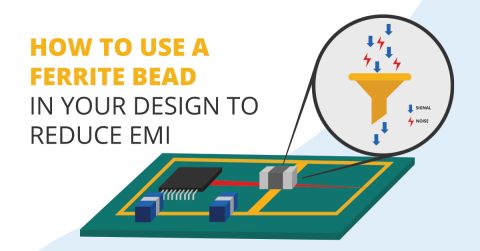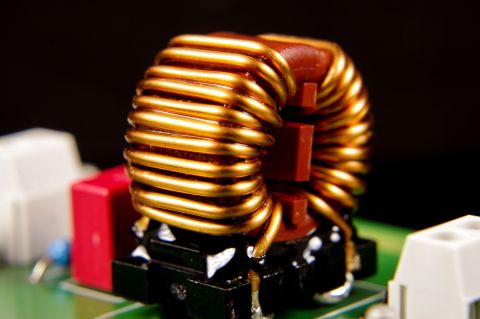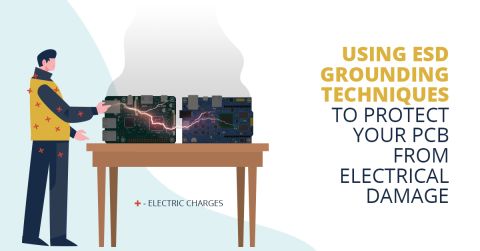Top 10 Switching Regulator Modules

Switching regulator modules are now an essential feature of a broad range of electronic devices, offering a more efficient method of converting voltage from one level to another by storing and releasing energy. The key to success is to find a great voltage regulator that offers the best performance to match your circuit's needs.
A great voltage regulator is an efficient regulator that keeps output ripple to a minimum. However, choosing the suitable regulator can be challenging as the efficiency rating in a vendor's component list does not tell you the whole story.
Efficiency inherently depends on input voltage and output current, which will vary for each application. Some regulators appear to offer hyper-efficient performance. However, studying the small print reveals that this rating only applies to maximum loading, and the efficiency is significantly poorer under light loads. This discrepancy is why knowing the regulator's performance under conditions that match your application's operating parameters is essential.
The Performance Rating Challenge
You can see an excellent example of the challenge of finding a regulator with the best rating for your needs with the Monolithic Power Systems MEZD71202A-G. This component is an open-frame, 6.5 to 24V input step-down power module with 2A continuous output current and 5.0V output voltage. The vendor claims it provides up to 92% peak efficiency.
The challenge for the designer is that the datasheet features an efficiency graph but only shows the efficiency curve over 60% loading with a 12V input. However, if you're using this regulator with a microcontroller in a circuit with occasional high current demand, you'll rarely see this efficiency level. The average efficiency dips to 27% with loads below 20mA. It sits at around 36% for loads below 70mA, which are typical loads for the operation of most microcontrollers, including the powerful ARM-Cortex devices.
The problem is that this lack of comprehensive data applies to all manufacturers.
Regulator Model Rating
The best way of finding the perfect voltage regulator for your circuit is to compare the real-world performance of the voltage regulator modules available against the specific requirements of your circuit design. This is where this article will help, showing you how these components work once they're out of their packaging and connected up in the lab. It will also reveal the top 10 picks based on efficiency and noise.
The reported findings are the results of testing voltage regulator modules undertaken over eight months, generating nearly 40 million data points. These tests focused on switching regulators designed to replace 5V or 3.3V low drop-out linear regulators.
The results are from testing 40 different voltage regulators this year, most with between 500 mA and 2A rated load. All the test data is available online at partplayground.com to explore and use to draw conclusions.
Overview of Results
A great way to get an overview of the differences between brands is to compare the measurements taken for comparative results. Charts of average efficiency with the min/max area indicating the bounds of their efficiency provide a great relative indication of brand performance.
Switching Regulator Efficiency by Brand
The following image shows the results of measurements of regulator efficiency by brand at 1A load. Visualizing the results of measurements of this kind makes it simple to spot trends in the data. In this example, the visible trends appear to show that some brands perform better on average than others. However, the devil is in the detail, so bear in mind that each brand's sample sizes are different, so you should exercise caution before drawing conclusions.
However, this chart does show us that beyond about 300mA of load, regulators from across the range of manufacturers tend to reach a reasonably steady efficiency rating. This information tells us that most brands will perform decently above 300mA load when dealing with regulators in the 500mA to 2A load range.

The data shows a vast range of different efficiency ratings when looking at regulator efficiency with loads below 100mA, going from a lowly 15% to an impressive 99%. The chart below expands this section of the results to make the differences easier to interpret.

The graph shows that if you are looking for a switching voltage regulator to use in an application with predominantly low loading, you are better off conducting representative testing on potential candidates rather than relying on datasheet information. Alternatively, you can save some time and effort and look at the data collected in the testing for this article and made publicly available at partplayground.com.
The variation in efficiency shown in the graph above could also be due to some voltage regulators having a wider input voltage range than others, causing certain brands on the chart to display poor efficiency. You can make allowances for this by looking at the following chart, which shows efficiency across all regulators based on the input and output voltage ratio. As the dataset includes regulators with a wide range of output voltages, presenting the data based on the ratio makes the most sense.

Most tested regulators had an input-to-output voltage ratio of less than 6. Therefore, beyond this ratio, fewer regulators contributed to the dataset. However, based on the available data, input voltage significantly influences the regulator's efficiency, especially under light loads.
Switching Regulator Noise Levels by Brand
Another important consideration in selecting a switching voltage regulator is the noise levels on the output voltage. Ripple artifacts from the switching logic can create issues in some circuit designs, and it's always easier and more practical to choose a regulator with low noise levels that add additional components to your circuit to reduce noise levels if they are too high.
The following graph compares the noise performance by brand, with the same caveat as the efficiency comparisons: the different sample sizes for each branch can affect trend results.

These indicative results do show that, interestingly enough, some of the most efficient regulators also produce the lowest noise levels. Therefore, these two factors together indicate overall regulator performance quality.
The results of measuring noise levels for different input voltages also show that output noise levels remain relatively consistent for each regulator, with the cause of the most significant variation in output noise levels being loading changes.
Switched Voltage Regulator Scoring
I determined the top 10 switched voltage regulators by assigning each regulator a score based on the measured performance. Scoring took into account the maximum and average efficiency, with the absolute efficiency and noise levels at the 20mA and 70mA load points. The basis of the scores was the performance of each tested regulator in each metric relative to the performance of all the other regulators in the dataset.
I derived the scoring scheme so that the regulators that performed the best across all loads and produced the lowest noise levels would obtain the highest score. It was imperative to ensure that a regulator that did exceptionally well at one test point but badly at other test points did not skew the results with an artificially high score.
It's also important to note that the scoring is based purely on performance, so factors such as cost, output voltage, and output current rating do not influence the rankings.
So, let's now look at the top ten list of the switched voltage regulators that were tested and scored.
Switched Voltage Regulator Ranking
- In the top spot is the GAPTEC Electronic LMO78_05-1.0, which may not appear extraordinary at first glance of the available product information due to its minimalistic datasheet. Test results show that this regulator boasts an impressive maximum efficiency of 99.3% and a solid average efficiency of 82.2%, with a respectable low average noise of 5.54mV. Under light loads of 70mA and 20mA, it maintains its strong performance, with efficiencies of 77.5% and 77.7%, respectively. It demonstrates an excellent load-step response but takes some time to start up, which might disqualify it for some applications.
- In the second place spot is the GAPTEC Electronic LCB78_05-0.5. This regulator also lacks sufficient datasheet information, with only an efficiency vs. input voltage chart at full load and a noise chart. Despite this, it matches the top model's maximum efficiency of 99.3% but falls just a bit short with an average efficiency of 81.2%. It maintains a decently low average noise at 5.19mV, increasing slightly to 5.34mV under a 20mA load.
- Taking the third place spot is the Traco Power TSR 2-2433. Incredibly, the datasheet for this component doesn't include any charts, hiding its potential. This 3.3V 2A regulator delivers a maximum efficiency of 95.5% and an average efficiency of 81%, all while keeping noise to a minimum at an average of just 3.79mV.
- Next in the number four place spot is the CUI VX7803-500. This 3.3V 0.5A regulator delivers a high maximum efficiency of 98.8% and an average efficiency of 76.8%. While it maintains a moderate noise level at 4.38mV, the average noise increases to 6.82mV for loads less than 20mA.
- In fifth place is the XP Power VR05S05. This 5V 0.5A regulator manages to reach a high efficiency of 95.2% and an average of 80.5% while maintaining a reasonably good noise level of 4.85mV at high loads. The noise levels do increase at lower loads, but efficiency remains within a comfortable range.
- In sixth place is the Traco Power TSR 1.5-2433E. This 3.3V 1.5A regulator scores well, with an overall efficiency of 94.6% and a reasonable average of 77.9%. With low-voltage-ripple operation featuring an average noise level of 3.27mV across its full load, it does exhibit a slight efficiency dip at lower loads but remains a solid choice.
- In seventh place is the CUI VXO7803-1000. This 3.3V 1A regulator has a solid maximum efficiency of 94.7% and a relatively good average efficiency of 77.8%. However, it has higher noise levels than its top 10 peers, measuring an average of 6.23 mV.
- In eighth place is the Recom Power R-78C5.0-1.0. Its maximum efficiency hits 94.2%, and it delivers an average efficiency of 77.5%. This 5V 1A regulator has a low noise figure of 3.73mV at full load. However, efficiency does drop more noticeably at lower loads, coming in at an average of just 60.4% for loads under 20mA which is the lowest of the regulators in this top 10 list.
- In ninth place is the GAPTEC Electronic LME78_05-1.0. This 5V 1A regulator has a maximum efficiency of 93.4% and an average efficiency of 78.4%. Noise levels are a bit higher, with an average of 6.1mV, but it performs reasonably well under lower load conditions.
- Finally, in tenth place, we have the GAPTEC Electronic LMO78_05-0.5. This 5V 0.5A module achieves an impressive 94.7% max efficiency and an average of 78.1%. Despite the slightly higher noise level at 6.31mV, it's a competent regulator under lower loads, although efficiency does drop to 65.5% for loads under 20mA.

Outside the top ten but worthy of an honorable mention are the regulators produced by Würth Elektronik. These components have the highest standard of datasheets for all the regulators examined here, which is why I often choose to use them. The best Würth Elektronik regulator scored twelfth place under the scoring method used for this ranking, though if product support and datasheet quality had been factors, they would have scored much higher.
Conclusion
Choosing the best switching voltage regulator for your circuit design shouldn't be difficult. Suppose you know the key parameters such as input and output voltages, output current across the loading range, and maximum acceptable noise levels. In that case, you should be able to pick one based on factors such as efficiency, cost, and packaging.
One of the key takeaways from this exercise has been the lack of clear, reliable, and comprehensive performance data from the datasheets of the tested voltage regulator modules. Without access to key performance parameters, chances are that you may miss out on the best options.
The goal of the exercise has been to produce an information set of real-world performance data to help you select the best regulator for your design projects, with all the many millions of data points available at partplayground.com if you want to perform your analysis or ranking. Keep your eyes open for more real-world component analysis videos coming soon. Don't forget to watch the accompanying video to learn more about the testing and the results.
When you're ready to create your PCB layout with a voltage regulator module or IC, use the design and layout tools in Altium Designer®. To implement collaboration in today’s cross-disciplinary environment, innovative companies are using the Altium 365™ platform to easily share design data and put projects into manufacturing.
We have only scratched the surface of what’s possible with Altium Designer on Altium 365. Start your free trial of Altium Designer + Altium 365 today.










